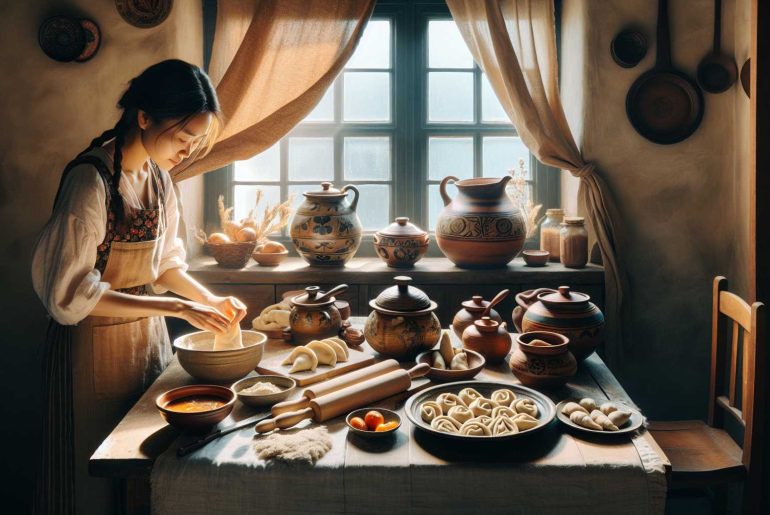 Poznań, in the heart of Poland, is a place where the tradition of home cooking is alive and well. This city, rich in Polish culture, invites those who love food to dive into its comforting and traditional dishes. These recipes have been around for generations, and the local markets full of fresh produce add to the city’s culinary charm.
Poznań, in the heart of Poland, is a place where the tradition of home cooking is alive and well. This city, rich in Polish culture, invites those who love food to dive into its comforting and traditional dishes. These recipes have been around for generations, and the local markets full of fresh produce add to the city’s culinary charm.
So, what makes Poznań’s home cooking unique, and how does it reflect the wider Polish culture? Let’s explore this city’s culinary world together and discover what makes it so special.
Discovering Poznań’s Culinary Roots
Exploring Poznań’s food scene, we uncover a history of culinary richness influenced by both local traditions and a variety of external sources. Poznań has long been a center for trade, dating back to the medieval era, which allowed it to absorb and integrate flavors from all over Europe and beyond. This mix of foreign culinary ideas with the city’s own agricultural products and meats has created a distinct food identity unique to Poznań. The city’s place in the Wielkopolska region, with its rich and fertile soil, further contributes to this identity. Here, the wide availability of different ingredients supports a broad and flavorful menu that showcases Poznań’s openness to the world yet stays rooted in local tradition.
For instance, consider Poznań’s famous dish, ‘Pyrzoki,’ a testament to the region’s love for potatoes and a prime example of local culinary innovation. This dish, essentially potato dumplings stuffed with meat or cottage cheese, captures the essence of Poznań’s cuisine: simple, hearty, and deeply influenced by the land. Another example is ‘St. Martin’s Croissants,’ a pastry filled with white poppy seeds, nuts, and raisins, highlighting the city’s ability to blend local agricultural products with culinary techniques introduced through trade and cultural exchanges. These dishes not only offer a taste of the city’s culinary heritage but also tell the story of Poznań’s historical interactions and connections with the broader world.
In discussing Poznań’s culinary scene, it’s essential to note how the city’s history as a trade center has fostered a culture of culinary diversity and innovation. The constant flow of goods and ideas has enriched Poznań’s food traditions, making them more varied and interesting. As a result, when visiting Poznań, one can enjoy a range of dishes that reflect the city’s rich past and its continuous evolution. Whether it’s through traditional dishes that have been passed down through generations or new culinary creations that experiment with local ingredients in novel ways, Poznań offers a unique and engaging food experience that is deeply rooted in its history yet always looking forward.
Traditional Dishes You Must Try
When you’re in Poznań, trying out the local cuisine is a must. It’s a great way to dive into the city’s culture and history. One dish you shouldn’t miss is ‘Pyrzyki’. It’s Poznań’s take on the famous Polish pierogi, but with a twist. Pyrzyki are filled with a delicious combination of meat, cabbage, and mushrooms. This mix perfectly captures the seasonal flavors of the Wielkopolska region. It’s a delicious example of how local ingredients can create something truly special.
Another dish that showcases the simplicity yet richness of Polish cuisine is ‘Szczawiowa’. This is a sorrel soup known for its tangy flavor, thanks to the sorrel leaves. It’s a great choice if you’re looking for something light yet flavorful, offering a nice balance to the more hearty meals.
Trying these dishes is more than just eating; it’s about connecting with Poznań’s cultural identity. Each recipe tells a story of the region’s history and the people who live there. So, when you’re exploring Poznań, make sure to give Pyrzyki and Szczawiowa a try. They’re not just food; they’re a taste of the city’s rich cultural tapestry.
The Heart of Polish Comfort Food
Polish comfort food offers a journey into a culinary tradition that celebrates the country’s rich history and welcoming spirit. At the heart of this tradition are dishes known for their hearty flavors, which come from recipes passed down from one generation to the next. These dishes typically use simple ingredients found locally, but over time, they’ve been perfected to create a taste that’s both comforting and deeply satisfying. This is a reflection of Polish values, emphasizing the importance of community and family.
For example, pierogi, kielbasa, and bigos are not just popular dishes; they represent the Polish way of valuing meals that bring people together and provide comfort. Each of these dishes tells a story of Poland’s cultural appreciation for food that not only tastes good but also fosters a sense of belonging.
Let’s delve into pierogi, for instance. These dumplings can be filled with a variety of ingredients, from potatoes and cheese to fruits for a sweet treat. They showcase the versatility of Polish cuisine and how it can cater to different tastes while still bringing people together. Kielbasa, a type of Polish sausage, is another staple that adds a flavorful punch to any meal. Bigos, often referred to as hunter’s stew, combines various meats with sauerkraut and is a perfect example of how traditional recipes are designed to warm you up from the inside.
These dishes do more than just feed the body; they nurture the soul by creating moments of togetherness and joy. This is why Polish comfort food is about more than just eating; it’s an experience that ties back to the core values of Polish culture: community, family, and hospitality.
Local Markets and Ingredients
Polish comfort food, known for its heartiness and flavor, owes much to the fresh, local ingredients found in markets throughout Poland. These markets, some of which have been around for hundreds of years, are more than just places to shop. They are the heart of Poland’s food culture, connecting local farmers directly with the people who cook and eat their produce. This direct line from farm to table not only ensures the quality of the ingredients but also keeps Polish culinary traditions alive.
At these markets, you can find everything needed for traditional Polish recipes: vegetables that change with the seasons, dairy products like fresh cheese and creamy butter, various meats, and grains. It’s this variety that allows Polish cuisine to be both diverse and rich in flavor. For example, in the spring, you might pick up fresh cabbage and young potatoes for a light stew, while in the winter, root vegetables and hearty meats dominate the market stalls for dishes like bigos, a traditional meat and cabbage stew.
But these markets offer more than just ingredients; they’re a place where cooking knowledge and traditions are passed down. Imagine walking through a market and overhearing conversations about the best way to make pierogi, or finding a vendor who shares a family recipe for sour rye soup. This exchange of knowledge helps keep Polish culinary traditions vibrant and evolving.
Preserving these markets is crucial for maintaining the authenticity of Polish cuisine. They’re not just shopping venues; they’re cultural hubs where the community comes together over a shared love of food. As such, they play a key role in ensuring that traditional Polish cooking methods and recipes are not lost but instead continue to be a significant part of Poland’s culinary heritage.
Home Cooking Experiences in Poznań
In Poznań, the practice of home cooking dives deep into the heart of Polish culinary traditions, thanks to the abundance of local markets filled with top-notch ingredients. The city’s kitchens become stages where generations-old recipes come to life. These recipes are more than just instructions for making dishes like pierogi, bigos, and kotlet schabowy; they’re cherished treasures handed down through families, keeping the city’s cultural identity alive. Cooking at home in Poznań isn’t just about feeding oneself; it’s a way of holding onto history and sharing stories that define what it means to be Polish.
For example, the process of making pierogi at home is a labor of love. It involves preparing the dough, choosing fillings that range from savory to sweet, and carefully sealing each dumpling before cooking. This isn’t just about following a recipe—it’s about recreating a piece of cultural heritage and connecting with ancestors who did the same. When people in Poznań cook these traditional dishes, they’re not just eating; they’re engaging in a dialogue with the past.
Moreover, this tradition of home cooking offers insights into the broader Polish culture beyond what you can find in restaurants or cookbooks. It shows how food is more than sustenance; it’s a form of communication, a way to bring people together, and a method of preserving history. For those looking to experience Polish culture authentically, participating in or observing the home cooking practices in Poznań is invaluable.
In essence, the act of cooking and sharing meals in Poznań homes goes beyond the kitchen. It weaves personal stories with the larger fabric of Polish society, creating a rich tapestry of cultural identity that is both preserved and continuously evolving. Through these culinary practices, the people of Poznań celebrate their heritage, ensuring that the flavors and stories of their past will continue to nourish future generations.
Conclusion
To sum it up, Poznań is a great place to dive into traditional Polish cooking. It’s full of classic dishes that really show what Polish comfort food is all about.
What makes it special is how the city uses fresh ingredients from local markets to create authentic home-cooked meals. This not only keeps Polish food traditions alive but also makes Poznań a must-visit for anyone who’s into exploring genuine Polish flavors.
So, if you’re keen on getting a real taste of Poland’s culinary culture, Poznań should definitely be on your list.







Comments are closed.